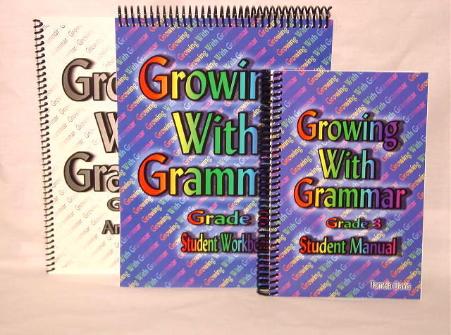The Growing with Grammar series fulfills the need for a religiously neutral, intensive grammar program for the elementary grades that includes sentence diagramming. Written by a homeschooling mom, these courses are very practical for busy homeschooling parents. Each course is laid out for a 36-week school year, with grammar lessons for about three days per week, although this can certainly be adjusted. Review questions are included within most exercises, and there are comprehensive reviews at the end of each of the major sections of each course.
The first two levels, Grade 1 and Grade 2, are designed a little differently than the rest of the levels. Both of these early levels are presented in a single worktext that includes all instructional information and exercises. These two worktexts have a plastic, spiral binding at the top of the book rather than the side to suit both right-handed and left-handed writers.
Grammar instruction is more intensive and is presented earlier than in some other programs. In first grade, students learn about the four types of sentences, subjects, predicates, nouns, pronouns, verbs (including present and past tenses and irregular verbs), articles, and adjectives as well as other topics such as synonyms, homonyms, and alphabetical order. The print is large and easy to read, and there is plenty of space for students to write their answers.
Most first graders will not yet read well enough to read the instructions or exercises independently, so a parent will need to work closely with a child through the lessons until they read well enough to operate independently.
Beginning with Grade 3, the format changes. For each level, there are both a Student Manual and a Student Workbook. The Manual is a half-size book, spiral bound on the left. These range in size from 238 pages for Grade 3 through 330 pages for Grade 6. Books are arranged into chapters and lessons, but they read more like a reference handbook since this is where we find the instructional information followed by examples. For example, Chapter 2 of Grade 6 begins with the definition of a noun and the definition of common nouns, followed by examples of common nouns. As is typical of traditional grade-level grammar programs, much of this information is repeated every year! These books could easily be used as reference handbooks if they only had indexes. Without indexes, you have to locate topics by looking through the table contents. This is fine since the author intends that students will work through lessons in a fairly sequential fashion, but I would love to see future editions with indexes so they could be even more useful.
Student Workbooks are full-size, again with a plastic spiral binding on the top like the Grade 1 and Grade 2 books. Pages are not numbered, but each workbook seems to have only slightly fewer pages than its companion Student Manual. A fairly large font and plenty of space for writing is standard throughout all levels, so students are not likely to feel overwhelmed by the amount of work they confront, even at the upper levels. Books are printed in black-and-white with occasional clip art illustrations—more illustrations in lower levels and hardly any in Grade 6. An Answer Key comes with each Student Workbook or with a complete set of a Student Manual and Student Workbook.
Grade 3 reviews topics taught at younger levels but adds adverbs to the parts of speech. Sentence diagramming is introduced at this level. Diagramming shows up in the first chapter, teaching diagramming of subjects and predicates, including compound subjects and compound predicates. Among other topics addressed in Grade 3 are possessive nouns, possessive and personal pronouns, subject-verb agreement, helping verbs, direct objects, punctuation of quotations, comma usage, and abbreviations. Although this is primarily a grammar course, some lessons address composition skills. In Grade 3, students learn to write paragraphs, friendly letters, and thank you letters. (Instruction deals more with the mechanics so please use another resource for more comprehensive composition skill development.)
Grade 4 adds prepositions, conjunctions, and interjections, including extensive work with prepositional phrases. Composition lessons target narrative paragraphs, business letters, invitations, thank you notes, descriptive paragraphs, and book reports.
Grade 5 introduces more complex variations of topics taught at earlier levels while it covers reflexive pronouns, subject-verb agreement, prepositional phrases used as adjectives or adverbs, appositive adjectives, and similar concepts. Outlining and informative paragraphs are added to the composition skills.
Grade 6 adds collective nouns, perfect verb tenses, independent and dependent clauses, complex sentences, adjective clauses (and how to diagram them), adverb clauses (and how to diagram them), using colons, using semicolons, and using hyphens as it continues to go further in-depth on topics taught previously.
Grades 7 and 8 are available, but I have not yet reviewed them.
Even when the lesson material is almost identical to that taught previously, the author has changed the wording and examples from grade to grade. However, as I've suggested with A Beka Language and similar programs that repeat the same material year after year, I would personally recommend that students skip at least every other year so they don't get burnt out on the repetition.
Lessons in Student Workbooks are numbered to correspond to lessons in the Student Manual. Review exercises indicate the lesson where the concept was taught in parentheses [e.g., (3.9) indicates lesson 3.9 in the Student Manual]. This allows students to easily go back and review lesson material from the manual when needed. With younger children, parents might need to help them identify the correct workbook lessons until they understand how the lessons correlate. I expect that most students will be able to work independently through the lessons at about Grade 3 level, a feature that many parents are likely to appreciate.










